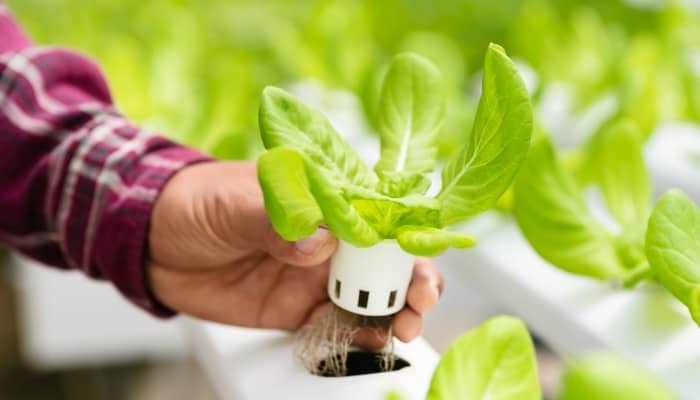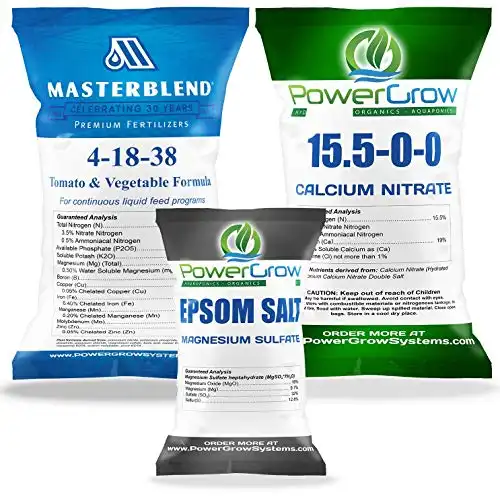Hydroponic lettuce is a top pick for many gardeners due to its ease of cultivation and its space-efficient nature compared to conventional gardening. It thrives in a water-based, nutrient-dense environment rather than soil. This offers the advantage of enabling the lettuce to take in nutrients more effectively.
Hydroponics for growing is becoming increasingly popular due to its many benefits, including faster growth rates, higher yields, and a reduced risk of pests and diseases.
And with the right knowledge and equipment, growing hydroponic lettuce can be a rewarding and enjoyable experience for gardeners of all skill levels.
Everything You Need for Growing Lettuce Hydroponically
Understanding the Hydroponic System
Hydroponic growing is a soilless method of growing plants that uses a nutrient-rich water solution to feed the plants. The hydroponic system can be set up in various ways, such as deep water culture, aeroponics, and drip irrigation, among others. The system allows the plants to grow in a controlled environment, helping to increase the yield and reduce the risk of pests and diseases.
Choosing the Right Growing Medium
The growing medium should provide support to the plants and hold enough moisture to keep the roots hydrated. Some of the commonly used growing mediums for hydroponic lettuce growing include rockwool, perlite, vermiculite, coconut coir, and clay pebbles.
Each growing medium has its own set of advantages and disadvantages, and the choice depends on the grower’s preference and the type of hydroponic system used.
Importance of Nutrients in Hydroponic Growing
Nutrients play a vital role in hydroponic growing, as the plants are not growing in soil that naturally contains nutrients.
The nutrient solution used in hydroponic growing should contain the essential elements required for plant growth, such as nitrogen – phosphorus – potassium (NPK), calcium, magnesium, and sulfur, among others. The pH level of the nutrient solution should also be maintained within a specific range, usually between 5.5 and 6.5, depending on the type of plant being grown.
The grower should regularly monitor the nutrient solution’s pH and nutrient levels to ensure that the plants receive the required nutrients and the solution’s pH level is within the optimal range. Overfeeding or underfeeding the plants can lead to nutrient deficiencies or toxicity, which can adversely affect the plant’s growth.
Learning How to Grow Hydroponic Lettuce
Growing hydroponic lettuce can be a rewarding experience for anyone looking to cultivate fresh and healthy greens in a controlled environment, indoors or out. Hydroponic lettuce is grown without soil, using a nutrient-rich solution that provides all the necessary minerals and vitamins for the plant to thrive. Here are some tips on how to grow hydroponic lettuce successfully.
Starting from Seeds: Lettuce Seedling Care
Starting with high-quality seeds is crucial to growing healthy hydroponic lettuce. Choose a variety of lettuce that is well-suited for hydroponic growing, such as Bibb, Romaine, or Tom Thumb lettuce.
Start the seeds in a small container with a growing medium that is moist but not soggy. Cover the container with plastic wrap to create a humid environment for the seeds to germinate. Once the seedlings have sprouted, remove the plastic wrap and place the container under grow lights or in a sunny window.
Planting Your Lettuce in the Hydroponic System
When the lettuce seedlings have grown to a suitable size, it’s time to transplant them into the hydroponic system. Choose a hydroponic system that best suits your needs, such as a deep water culture or nutrient film technique.
Fill the hydroponic system with the nutrient solution and adjust the pH level to between 5.5 and 6.5. Gently remove the lettuce seedlings from the container and place them into the hydroponic system. Make sure the roots are fully submerged in the nutrient solution.
Regular Plant Care to Grow Well
To ensure that your hydroponic lettuce grows well, it’s important to provide regular plant care. Check the nutrient solution levels daily and top up as needed. Keep the pH level within the optimal range by testing it regularly and adjusting it as needed.
Monitor the temperature and humidity levels in the growing area to ensure they are within the recommended range for lettuce growth. Prune the lettuce leaves as needed to promote healthy growth and prevent overcrowding.
Finally, keep an eye out for pests or diseases and treat them promptly to prevent damage to your lettuce plants.
The Best Types of Lettuce to Grow Hydroponically
Identifying the Best Types of Lettuce
When it comes to growing lettuce hydroponically, certain types of lettuce are better suited for the method than others. Leafy greens like lettuce are a great choice for hydroponic gardening due to their shallow root systems and fast growth rates. However, not all lettuce varieties are created equal.
Different Lettuce Varieties for Your Salad Bowl
There are over a thousand lettuce varieties grown today. Of these thousand varieties, many types of lettuce are incredibly common because of their flavor, color, disease resistance, and growth speed.
Here are some of the most popular types and interesting lettuces to grow hydroponically in your lettuce garden:
Butterhead
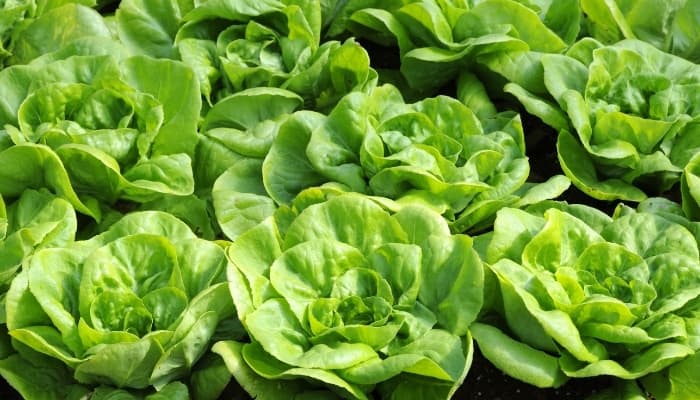
This variety of lettuce has bright green, velvety, slightly ruffled leaves and a sweet butter-like flavor, hence the name. Some types of Butterhead lettuce are dark green or red. Bibb and Boston lettuce are both types of Butterhead lettuce.
Romaine
One of the most recognized and well-known varieties, Romaine lettuce has characteristically long leaves. The texture is crisp, and the flavor is slightly sweet.
Little Gem
Described as a combination of Butterhead and Romain, Little Gem is juicy with a thin center stalk that gives structure without too much crunch.
Lollo
Wide, frilly leaves and a loose head define Lollo lettuce. This is a popular variety for baby leaf production.
Red Sails Lettuce
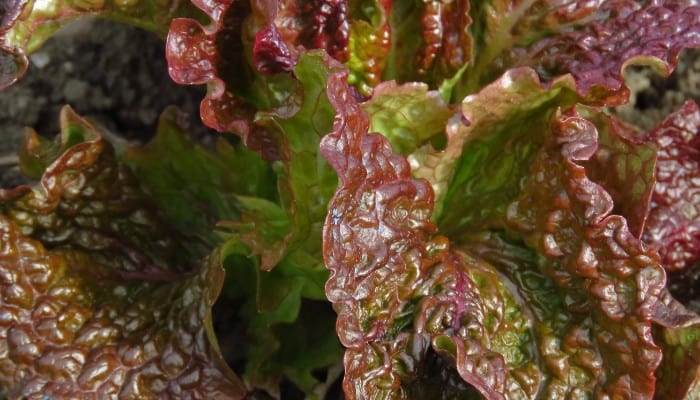
With its ability to thrive in variable weather, Red Sails Lettuce is an ideal variety to grow hydroponically. The loose, upright leaves of Red Sails allow for excellent air circulation and light exposure in hydro systems, leading to fast, healthy growth and vibrant red coloration.
Salad Bowl Lettuce
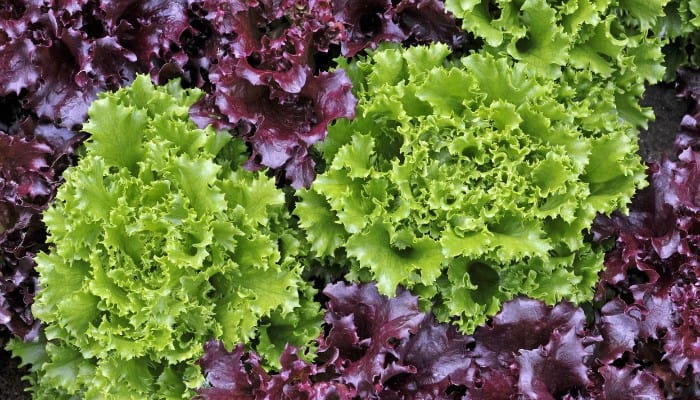
Salad Bowl is a loose-leaf lettuce prized for its tender, ruffled leaves and versatility in both hot and cold weather. The open growth habit of Salad Bowl is perfect for hydroponic culture, allowing for good air flow and light penetration for optimal growth and yield.
Another great thing about lettuce is that it grows well in tandem with other leafy vegetables and herbs. As long as the plants share similar nutritional needs, they can be grown in the same container or from the same reservoir.
Good things to grow alongside lettuce are spinach, kale, basil, mint, swiss chard, endive, escarole, arugula, watercress, and more.
Ready to grow some hydroponic lettuce? It all starts with quality seeds. Check out TrueLeaf Market for 20+ varieties of lettuce seeds!
Lettuce Needs: Unique Characteristics of Different Varieties
Different lettuce varieties have unique characteristics that make them better suited for certain growing conditions. For example, Romaine lettuce is a heat-tolerant variety that can withstand higher temperatures than other lettuce varieties.
Butterhead lettuce, on the other hand, prefers cooler temperatures and higher humidity levels. Looseleaf lettuce varieties like Red Sails and Salad Bowl are more tolerant of heat and can be grown in warmer conditions.
When choosing the best types of lettuce to grow hydroponically, it’s important to consider the specific needs of each variety. By selecting the right lettuce varieties for your hydroponic garden, you can ensure a bountiful harvest of fresh, crisp lettuce for your salad bowl.
The Process of Growing Lettuce Hydroponically
Growing lettuce hydroponically is a simple and efficient way to cultivate fresh, healthy greens year-round. Here are the key steps involved in the process.
Stages of a Lettuce Plant’s Life
Lettuce grows quickly and has a relatively short life cycle of around 8-12 weeks. The process of growing lettuce hydroponically involves the following stages:
- Germination: This is the first stage of a lettuce plant’s life. Seeds are planted in a growing medium, and the nutrient solution is added to the container. The seeds will sprout in a few days and start to grow.
- Vegetative growth: During this stage, the lettuce plant will grow leaves and roots. It is important to monitor the nutrient solution’s pH and adjust it as needed to ensure the plant gets the right nutrients.
- Flowering: As the lettuce plant matures, it will start to produce flowers. It is essential to remove the flowers as they appear to prevent the plant from going to seed.
- Harvest: When the lettuce is ready to harvest, the leaves will be full-sized, and the plant will be mature. Cut the leaves off the plant, leaving the stem and roots intact, and the plant will continue to grow new leaves.
Monitoring and Adjusting Nutrient Levels
To grow lettuce hydroponically, you need to provide the right balance of nutrients to the plant. The three primary nutrients that lettuce needs are nitrogen (N), phosphorus (P), and potassium (K). These are often referred to as NPK.
The ideal nutrient solution for lettuce contains around 150-200 ppm of N, 50-80 ppm of P, and 200-250 ppm of K. The pH of the nutrient solution should be between 5.5 and 6.5.
It is essential to monitor the nutrient solution’s pH and adjust it as needed to ensure the plant gets the right nutrients. If the pH is too high or too low, the plant will not be able to absorb the nutrients it needs.
Recognizing When to Harvest Your Lettuce
Lettuce is ready to harvest when the leaves are full-sized and the plant is mature. The ideal time to harvest lettuce is in the morning, after the plant has had a few hours of darkness.
When harvesting lettuce, cut the leaves off the plant, leaving the stem and roots intact. The plant will continue to grow new leaves, and you can harvest them again in a few weeks.
How to Store and Enjoy Your Hydroponic Lettuce
Harvesting and Storing Hydroponic Lettuce
When it comes to harvesting hydroponic lettuce, it’s important to remove the entire plant. This means cutting the stem at the base of the plant. This method will ensure that the plant doesn’t continue to grow and use up valuable nutrients. Once harvested, rinse the lettuce with cool water to remove any debris or dirt.
To store your hydroponic lettuce, wrap it in a damp paper towel and place it in a plastic bag. This will help to keep the lettuce fresh for up to a week. It’s also important to store the lettuce in the refrigerator at a temperature between 32-40°F (0-4°C).
Incorporating Hydroponic Lettuce into Your Meals
Hydroponic lettuce is a versatile ingredient that can be used in a variety of dishes. It’s a great addition to salads, sandwiches, and wraps. It can also be used as a topping for burgers or tacos.
When using hydroponic lettuce in your meals, it’s important to keep in mind that it is a leafy green that is high in water content. This means that it can wilt easily and become soggy if not used properly. To prevent this, it’s best to add the lettuce to your dish just before serving.
Hydroponic lettuce can also be used as a base for smoothies or green juices. It’s a great way to add some green to your diet and get the nutrients you need.
Conclusion: Taking Your Hydroponic Garden to the Next Level
Benefits and Satisfaction of Growing Your Own Lettuce Hydroponically
Growing lettuce hydroponically is a great way to enjoy fresh, healthy greens all year round. With a hydroponic garden, gardeners can grow lettuce without soil, using nutrient-rich water instead. This method of growing lettuce has several benefits, including:
- Faster growth: Hydroponic lettuce can grow up to twice as fast as lettuce grown in soil.
- Less water usage: Hydroponic gardens use 90% less water than traditional soil-based gardens.
- Less space needed: Hydroponic gardens can be grown vertically, saving space in small gardens or greenhouses.
- Fewer pests and diseases: Hydroponic gardens are less prone to pests and diseases, reducing the need for pesticides.
- Higher yields: Hydroponic gardens can produce higher yields than traditional soil-based gardens.
Growing lettuce hydroponically is also a satisfying experience. Gardeners can watch their lettuce grow from seed to harvest in just six to eight weeks. They can also experiment with different varieties of lettuce, from leafy greens to head lettuce and enjoy the taste of fresh, homegrown produce.
Frequently Asked Questions
What are the best hydroponic fertilizers for lettuce?
All of the macronutrients, nitrogen, phosphorus, and potassium, and many micronutrients are essential for healthy lettuce growth.
To supply the right balance of nutrients to your plants, you will need the right hydroponic fertilizer. A fertilizer high in nitrogen and potassium will work best.
For new growers, the easiest and most effective option is to get a premade dry mix of nutrients specially designed for lettuce. This will have the right balance of macro and micronutrients for lettuce and doesn’t require any special knowledge of fertilizers.
For more advanced growers, the best option is to make a dry fertilizer mix yourself. Getting the separate ingredients in bulk and measuring and mixing yourself will save you loads of money long-term and give you the most flexibility when it comes to plant nutrition.
A great all-in-one option is the Masterblend Complete Combo Kit Fertilizer. This package includes a 4-18-38 Tomato and Vegetable Formula, 15.5-0-0 calcium nitrate fertilizer, and Epsom salt.
By mixing one part Tomato and Vegetable Formula, one part calcium nitrate, and one-half part Epsom salt with pure water, you get a hydroponic fertilizer concentrate that can be diluted and make an incredible nutrient solution.
What is the hydroponic lettuce grow time?
The hydroponic lettuce grow time can vary depending on the variety of lettuce being grown. Generally, lettuce will take between 40 to 80 days to reach maturity. However, some varieties such as butterhead lettuce may take longer to mature. It is important to research the specific variety of lettuce being grown to determine the expected grow time.
What are the nutrient requirements for hydroponic lettuce?
Hydroponic lettuce requires a balanced mix of macronutrients and micronutrients. The macronutrients needed for healthy growth include nitrogen, phosphorus, and potassium. Micronutrients such as calcium, magnesium, and iron are also important. It is important to monitor the pH of the nutrient solution and adjust as needed to ensure that the nutrients are being absorbed properly.
What is the hydroponic lettuce harvest time?
The hydroponic lettuce harvest time will depend on the variety of lettuce being grown and the desired level of maturity. Generally, lettuce can be harvested when the leaves are large enough to be picked. It is important to harvest the lettuce before it becomes too mature and begins to bolt or develop a bitter taste.
How long does lettuce last in hydroponics?
Lettuce can last for several weeks in hydroponics if stored properly. After harvesting, the lettuce should be rinsed and dried thoroughly before being stored in an airtight container in the refrigerator. It is important to check the lettuce regularly and discard any leaves that show signs of decay or spoilage.
Is an air pump necessary for hydroponics?
An air pump is not always necessary for hydroponics, but it can be beneficial for promoting healthy root growth. An air pump can help to oxygenate the nutrient solution and prevent the buildup of harmful bacteria.
However, some hydroponic systems such as deep water culture do not require an air pump. It is important to research the specific hydroponic system being used to determine if an air pump is necessary.

